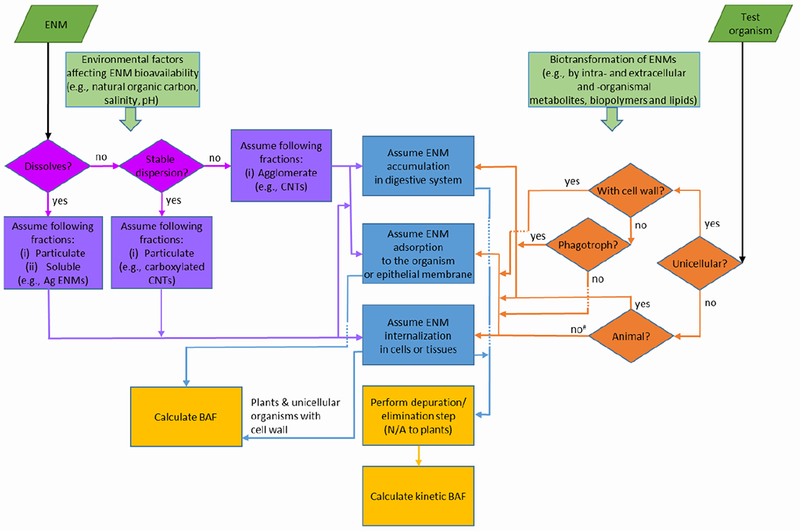Figure 1.

Scheme of decision steps, processes and factors important to consider in designing engineered nanomaterial (ENM) bioaccumulation tests and calculating bioaccumulation factors. The scheme depicts how the physicochemical properties of ENMs (purple boxes and violet diamonds) and the physiology of the test organism (orange diamonds) influence ENM internalization or adsorption to organisms or cell membranes (blue boxes) and the consequent steps for calculation of single metrics of ENM bioaccumulation (yellow boxes).
ENM interactions with cells and organisms (blue boxes) have been grouped based on the potential of ENMs to adsorb or become internalized into cells or tissues. Accumulation into the digestive system has been presented as a special case because ingestion is a significant uptake pathway of ENMs for certain types of organisms (e.g., filter feeders, phagotrophs, and fish). Whether or not ENMs are assimilated into the tissues or cells, or merely adsorbed on the epithelial membrane of the digestive system depends on the ENM physico-chemical properties and biotransformations in the digestive system. Regardless of their fate in the digestive system, ingested ENMs contribute to the total body burden of ENMs that can be transferred to subsequent trophic levels, and should be taken into account in bioaccumulation measurements. Based on the potential of ENMs to either dissolve or form stable aqueous dispersions (purple diamonds), ENMs can be divided into (1) water-soluble ENMs, such as ZnO, Cu, CuO, and Ag, with particulate and dissolved fractions interacting with organisms, (2) insoluble ENMs, such as carbon nanotubes (CNTs), graphene, boron nitride nanotubes or flakes, and TiO2, which are not water-dispersible and tend to agglomerate in environmental matrices and thus are less likely to be internalized into cells and tissues but may be adsorbed to organisms or cell membranes, and (3) insoluble ENMs that form stable aqueous dispersions, such as functionalized carbon or boron nitride nanotubes, graphene oxide, and TiO2 with hydrophilic coatings, and may interact in nanoparticulate forms (violet boxes) with organisms. In addition to intrinsic ENM properties, environmental factors affecting ENM bioavailability and ENM biotransformations need to be considered in the test design (light green boxes). Conversely, the ENM interaction with organisms depends on the structure and physiology of the latter (orange diamonds). For example, ENMs can accumulate in multicellular animals by entering the digestive system, adsorption to the organism, and internalization in the tissues (blue boxes). The pathway of ENM accumulation in the digestive system is excluded for multicellular plants (non-unicellular organisms which are not animals), unicellular organisms with cell walls (bacteria, fungi and green algae) and non-phagotrophic unicellular organisms without cell walls (some protists and mixotrophic algae). If no internalization of ENMs in organisms is assumed (e.g., in the case of insoluble poorly dispersed ENMs interacting with bacteria) or in case of plants and unicellular organisms with cell wall, an elimination step may not be necessary before quantifying bioaccumulated ENMs (yellow boxes). In this case, a bioaccumulation factor (BAF) can be calculated. If accumulation in the digestive system or internalization of ENMs is assumed, it is advisable to perform an elimination step for calculating a kinetic BAF.
